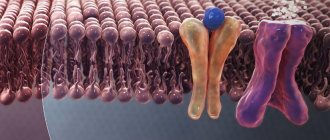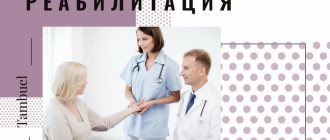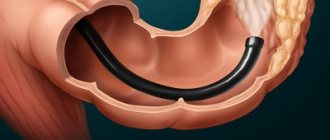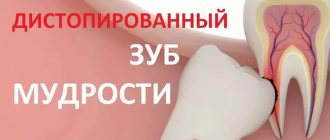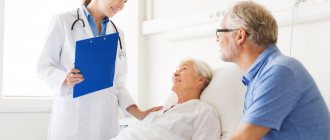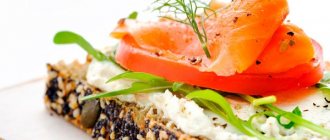What is this operation
A polyp is a benign tumor-like formation on a stalk or broad base, hanging from the walls of a hollow organ into its lumen. In some cases, tissue degeneration into malignant neoplasms is possible. Removal of polyps is done as part of the prevention of rectal cancer.
There are cases when polyps cause discomfort: abdominal pain and rectal bleeding. Removing them also helps relieve painful symptoms.
Nutrition in the third week after surgery
The surgeon assigns table No. 1b. It is a transition to a physiologically complete diet No. 1, lasts a week. The protein content in the diet increases to 100 g, carbohydrates already amount to 400 g. The energy intensity of the daily diet increases to 3000 kcal. The total volume of food is brought to 2.5–3 kg.
The nature of the diet changes: vegetable purees, meatballs, and steamed cutlets are added to liquid dishes. Semi-liquid buckwheat, oatmeal and rice porridges are prepared, sugar and butter are added to them (in a plate). A little honey is allowed in tea or with rosehip decoction. Pasta and legumes are not recommended.
Preparation rules
The operation is prescribed after a comprehensive examination. It implies:
- consultation with a coloproctologist and examination of the rectum with an endoscope;
- blood test for clotting and infections:
- consultation with a therapist and electrocardiogram;
- fluorography or RGC.
It may be necessary to discontinue medications taken to thin the blood. 3 days before removal of polyps in the intestine, a diet is followed. During this period, it is recommended to take liquid food and plenty of water. The preparation is the same as for a colonoscopy.
What foods can you eat after surgery?
The diet for intestinal anastomosis involves avoiding salt, seasonings and fat. Liquid cereals and dairy products are allowed. Fruits, vegetables, and boiled meat can only be eaten pureed. It is acceptable to drink freshly squeezed juices: apple, peach, apricot, carrot, beetroot.
It is forbidden to eat fatty, salty, smoked foods. Sour fruits and berries are also excluded. Tea, coffee, carbonated water and alcohol are prohibited. Following a diet during intestinal anastomosis will help you recover faster and protect against complications.
Operation procedure
Colonoscopy with removal of polyps under anesthesia takes from 30 to 60 minutes
. The patient lies on his back or side. The endoscope tip is inserted into the body cavity through the anus. The endoscopist slowly moves it down the rectum. A small amount of air is introduced into the colon to open it.
When the camera attached to the end of the endoscope tube records the location of the polyp, the doctor begins the stage of removing it. It is carried out using special mini-knives. Polyps can be cauterized by electric current. Upon completion of the operation, all instruments are removed from the intestine.
Questions about nutrition for patients with an ostomy
News 05/25/2020 What will a stoma look like? What sensations will I experience? What diet will I need to follow?
You and your family have many questions, doubts, and concerns. First, we suggest getting to know your stoma.
What is a stoma?
An intestinal stoma is an opening that is surgically created in the skin of the abdomen. The open end of the intestine is brought out through the stoma to remove feces, in cases where it is impossible for them to move further and be removed through the anus.
An stoma is always performed according to vital indications , which include:
- intestinal tumors;
- complicated inflammatory processes with abscesses, scars, abnormal narrowing of the intestinal lumen;
- congenital defects of the colon;
- injuries;
- Crohn's disease;
- nonspecific ulcerative colitis.
During the postoperative period, you should carefully monitor the integrity and color of the surgical suture line between the stoma and the skin.
Do I need to follow a diet?
After installing a stoma, doctors recommend adhering to certain dietary rules. This will help avoid constipation, gas, or indigestion.
Basic principles of nutrition during an ostomy:
- balance between energy expended and energy received during food intake;
- obtaining necessary nutrients;
- adherence to diet;
- fractional meals in small portions;
- sufficient fluid intake – up to 1.5 liters per day;
- moderate salt and sugar content.
There are no special diets for ostomy. The doctor selects a diet individually, taking into account your eating preferences. For the first time after surgery, we recommend keeping a food diary. It will help you determine which foods and in what quantities are acceptable to you. When their influence on the activity of the stoma is clear, you can stop keeping a diary.
After a few months, eating will not cause discomfort. Proper nutrition is an important condition for leading a full life.
What can you eat?
The diet includes varied and healthy foods. There are no special restrictions. But the main thing to remember is that certain foods can cause increased gas formation or bowel dysfunction. Therefore, you need to eat them in strictly defined quantities.
The table below shows the effect of certain foods and drinks on intestinal motility:
| Action | Product/drink | |
| Have a laxative effect | fatty foods, rye bread, green beans, fresh and dried fruits, spinach, cucumbers, fresh fruits, prunes, figs, nuts, beans, lentils, salads with mayonnaise, spicy dishes with seasonings, breakfast cereals, coffee, fruit juice, milk | |
| Increase gas formation | eggs, cabbage, onions, legumes, nuts, grapes, raisins, mushrooms, root vegetables, asparagus, chocolate, beer and carbonated drinks (kvass, beer, kumiss, carbonated water), root vegetables, mushrooms and fresh yeast baked goods | |
| They have a fixing effect. | rice broth, quince, blueberry jelly, mashed potatoes, hard cheeses, bananas, an abundance of animal proteins in the diet, mashed potatoes, noodles, pasta and any dough products (pancakes, pancakes, dumplings, dumplings), cottage cheese, flour baked goods and baked goods, strong tea | |
| Increases the odor of stool | eggs, fish, onions, peppers, garlic, spices, some types of cheese | |
| Reduces the odor of stool | spinach, green salad, parsley, lingonberry juice, yogurt |
How to cope with indigestion?
Bowel problems (constipation or diarrhea) are possible for anyone. But, you should be especially attentive to yourself, as these conditions can cause additional discomfort.
| CONSTIPATION |
|
| DIARRHEA |
|
Undoubtedly, having an intestinal stoma changes a person’s life. But a healthy lifestyle, enough water and following a diet will allow you to avoid digestive problems and lead an active lifestyle.
Read our Facebook to stay up to date with the latest events.
Was the information useful?
Diet after removal of colon polyps
The day after surgery, the patient can return to eating. It shouldn't be hard. In the near future you should avoid consuming:
- coffee, tea and carbonated drinks;
- spicy and fried foods;
- alcohol.
The menu after removal of polyps in the colon should include foods that do not cause irritation or bloating. It is recommended to use chicken broth and a small amount of oatmeal. Overeating for several days after surgery can lead to constipation.
Nutrition in the postoperative period
Surgery is a serious stress for the body. Stress greatly affects your metabolism. In order for the recovery processes in the patient’s body to suffer less, a careful approach to nutrition after surgery is needed.
Changes in metabolism after surgery or trauma are a risk factor for postoperative complications.
A patient's metabolic rate affects the speed at which he recovers from surgery or injury. If the body’s response to intervention is powerful, then the person becomes exhausted, the immune system weakens, and infection can easily develop. This complicates the recovery process. Why is this happening?
How the body reacts to surgery or injury
During surgery and trauma, stress hormones and cytokines enter the patient’s blood. Cytokines are substances that regulate inflammatory processes in the body. Inflammation is the body’s response to various injuries. This reaction activates the body's defenses - because any wound can cause infection. The release of cytokines and stress hormones into the blood changes metabolism. What are these changes? The process of glycogen breakdown starts - the body’s energy reserves are spent. Fats from adipose tissue and proteins from muscles are processed as additional sources of energy. Consumption of protein for energy needs does not allow it to be used for primary needs: the creation of new cells and tissues, i.e. wound healing. This interferes with the patient's recovery after surgery:
- When muscle volume has decreased, it is difficult for the patient to return to even minimal physical activity.
To improve the prognosis for the patient, it is necessary to supply his body with additional nutrients that provide easily digestible energy and protein. Prevention of general exhaustion has a positive effect on the immune system, increasing the defenses of the entire body. Even minimal nutrition has a healing effect on the cells of the intestinal mucosa, preserving the barrier function of the gastrointestinal tract against microbes.
Nutritional therapy - what is it? What are the indications for nutritional therapy in a surgical patient?
One of the components of supporting a patient on the path to recovery is nutritional therapy. This is nutrition for the patient, which is aimed at preventing or treating malnutrition. Nutritional therapy includes oral nutrition - a regular or therapeutic diet, enteral and parenteral nutrition.
Which surgical patient needs nutritional therapy?
- a patient without signs of malnutrition, if he is not expected to be able to eat for more than 5 days, or he will have problems taking enough food by mouth (less than 60% for more than 7 days)
- a patient who may be at risk of postoperative complications related to nutrition. Risk screening is performed when a patient has
- Body mass index (BMI) is less than 20.5 kg/m2
- Body weight loss greater than 5% in the last 3 months
- Reduced food consumption
- Serious condition
- Elderly age
Timely prevention of malnutrition significantly affects the outcome of the disease. How it looks in numbers - read the statistics below.
Some statistics from studies on the “prognostic impact of nutritional status on complications and mortality”
Early initiation of nutrition after surgery may be particularly questionable in the case of gastrointestinal surgery. But even here - subject to the rules of nutritional support - the percentage of complications and the time spent in the hospital are reduced. This is shown in a Cochrane review2 on the effect of early enteral nutrition on the incidence of complications after gastrointestinal surgery. Cochrane is a non-profit organization that analyzes published medical research and checks it against the principles of evidence-based medicine.
The review authors identified 14 studies, including 1224 patients. From these studies, they concluded that starting nutritional support within 24 hours of surgery shortens hospital stay by 1 day and reduces the incidence of some complications:
- Wound infection. In patients receiving nutrition, the risk was up to 13.4%, in controls who did not receive nutritional support - up to 33.3%
- Complications, suppuration of sutures. With nutritional support, the maximum risk fell from 27% to 8.3%
- Mortality. The risk of death decreased with early nutrition from 19% to 6.7%.
Special mixtures balanced in nutrients, vitamins and microelements are suitable as nutritional therapy.
Nutrien Stadard and Nutrien Energy products for restoring the body after surgery
Such mixtures include Nutrien Standard and Nutrien Energy. These are universal therapeutic products that are suitable for oral administration and enteral feeding through a tube after surgery and injury.
Both mixtures contain:
- milk protein, which is easily digestible,
- polyunsaturated fatty acids (omega-3), which contribute to anti-inflammatory and immunomodulatory effects,
- fats that do not overload the pancreas, are easily digested and provide quickly and a lot of energy,
- vitamins and microelements that accelerate all recovery processes in the body. Nutrien Standard is easier to digest and tolerate in the early postoperative period.
Nutrien Energy has a higher concentration of protein and energy, vitamins and minerals, and is better suited for later, long-term rehabilitation, when the gastrointestinal tract has recovered from surgical stress. Which of these mixtures is best? For an accurate answer, get recommendations from your doctor.
Nutritional therapy statistically improves a surgical patient's prognosis, but the nuances of nutritional support may vary from patient to patient. To get the most benefit from medicinal mixtures, it is important not only to understand how to organize your diet after surgery, but also to act in coordination with your doctor or nutritionist.
Share:
(0 ratings; article rating 0)
Treatment methods
At Global Clinic, two methods are used to treat anal fissure: conservative (medication) and operative (surgical intervention). The method of treatment is selected individually and depends on some features of the course of the disease:
- An acute fissure, which exists in most cases for less than 3 weeks, is treated with medications, ointments and blockades.
- If there is a chronic form of the pathology or if conservative treatment is ineffective, Global Clinic specialists recommend anal fissure surgery using the following methods:
- excision of the defect “acutely”, which involves two options: simple excision and one-step excision of the anal fissure with sphincterotomy;
- bloodless method - excision of the anal fissure using the radio wave method and laser surgery.
The bloodless method has a number of undeniable advantages:
- there is practically no postoperative swelling;
- fast recovery;
- The operation is performed under local anesthesia.
Global Clinic specialists use new generation devices - the IPG laser generator and the ForceTriad high-energy unit, which minimizes the risk of damage to healthy tissue.
When should you contact your healthcare provider?
Call your healthcare provider if you experience any of the following:
- diarrhea and fever 100.4°F (38°C) or higher;
- diarrhea and vomiting;
- diarrhea that does not stop for more than 24 hours;
- diarrhea, foul-smelling discharge, or increased leakage from the stoma.
If you have questions about your diet, call 212-639-7312 to speak with an outpatient dietitian.
You can contact a branch employee from Monday to Friday from 9:00 to 17:00. to come back to the beginning
